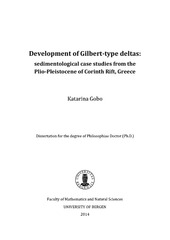Development of Gilbert-type deltas: sedimentological case studies from the Plio-Pleistocene of Corinth Rift, Greece
Doctoral thesis
Date
2014-05-28Metadata
Show full item recordCollections
- Department of Earth Science [1050]
Abstract
Gilbert-type deltas form where a river system debouches into a relatively deep marine or lacustrine basin, whereby the subaqueous delta slope is steep and fully dominated by sediment gravity-transport processes. These deltas occur in various tectono-geomorphic settings and have attracted considerable research interest in the last three decades or so, although mainly from the viewpoint of their large-scale architecture, spatialstratigraphic stacking pattern and relationship to basin-margin faults. Side-scan sonar studies of a number of such modern deltas provided highly instructive ‘snapshots’, but lacked the stratigraphic perspective of a deltaic system evolution with time. More recent detailed sedimentological studies of several ancient Gilbert-type deltas have meanwhile indicated that these sedimentary systems are some of the most valuable archives for the stratigraphic record of various allogenic and autogenic factors, most notably the record of relative base-level changes. The present series of case studies from the Plio–Pleistocene deltas in the Corinth Rift, Greece, elucidates further this conceptual notion by focusing on such key issues as: the ‘birth’ and subsequent evolution of Gilbert-type delta as a valley-fill bayhead system (Paper 1); the relationship between the delta-brink morphodynamics controlled by base-level behaviour and the mode of the subaqueous delta-slope processes of sediment dispersal (Paper 2); and the impact of these brink-to-slope temporal changes on the sedimentation pattern in the delta-foot zone (Paper 3). The application of detailed facies analysis has proven to be of crucial importance in unravelling the system formative conditions. The case studies highlight the significant role of the rift-margin tectonics, while revealing further the spatio-temporal patterns of the deltaic system’s own responses to tectonically-induced perturbations. This series of case studies from the Corinth Rift contributes to a better understanding of the morphodynamics of evolving Gilbert-type deltaic systems and their pattern of responses to both long- and short-term changes in base level. The studies contribute also to a better understanding of the Plio–Pleistocene tectonic development history of this youngest European rift basin.
Has parts
Paper I: Gobo, K., Ghinassi, M., Nemec, W. and Sjursen, E. Development of an incised valley-fill at an evolving rift margin: Pleistocene eustasy and tectonics on the southern side of the Gulf of Corinth, Greece. Sedimentology. Full text not available in BORA due to publisher restrictions. The article is available at: http://dx.doi.org/10.1111/sed.12089.Paper II: Gobo, K., Ghinassi, M. and Nemec, W. Gilbert-type deltas recording short-term relative base-level changes: deltabrink morphodynamics and related foreset facies. Full text not available in BORA.
Paper III: Gobo, K., Ghinassi, M. and Nemec, W. Reciprocal changes in foreset to bottomset facies in a Gilbert-type delta: response to short-term changes in base level. Full text not available in BORA.
